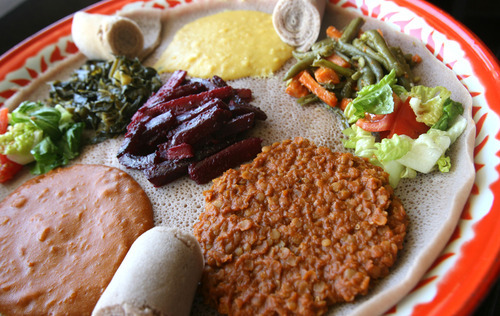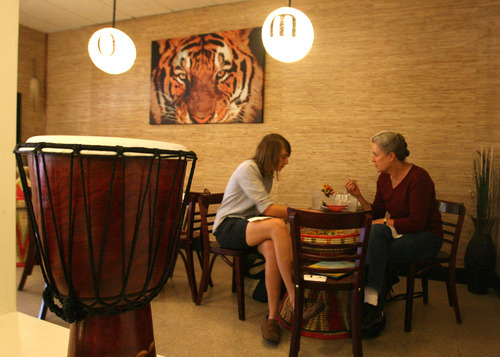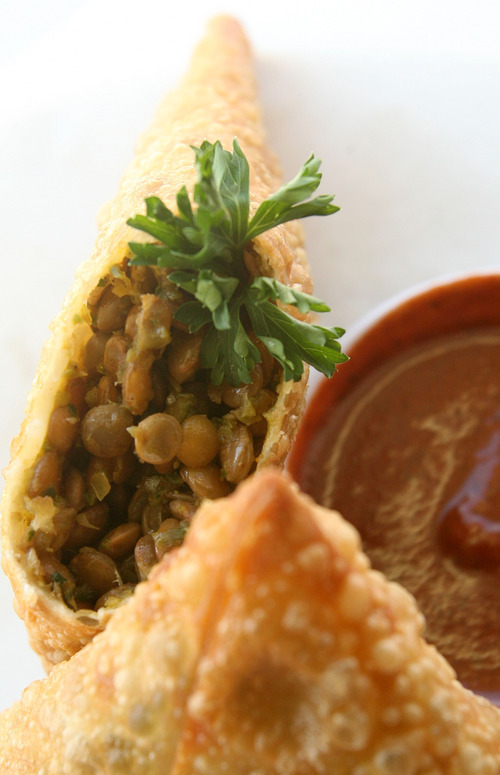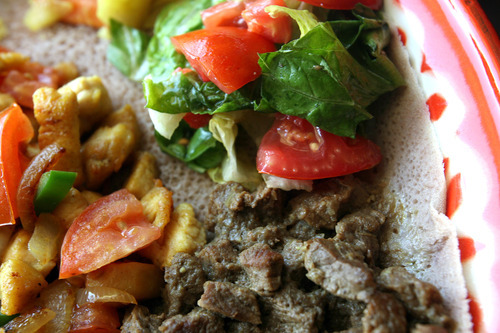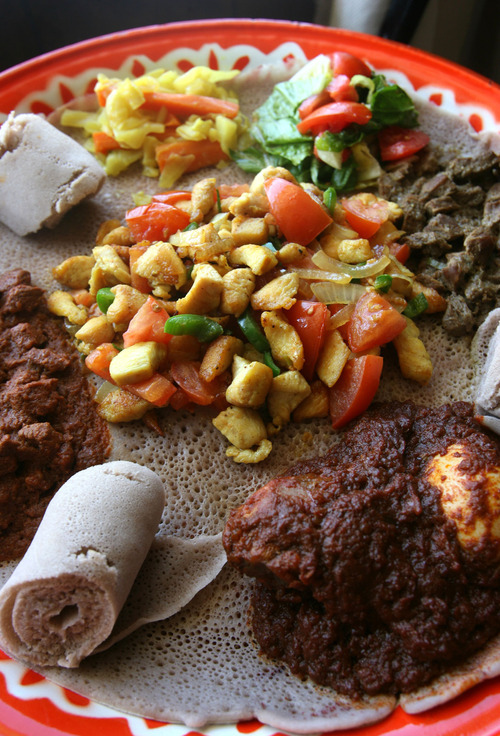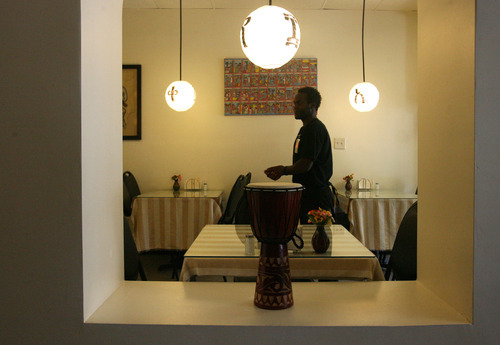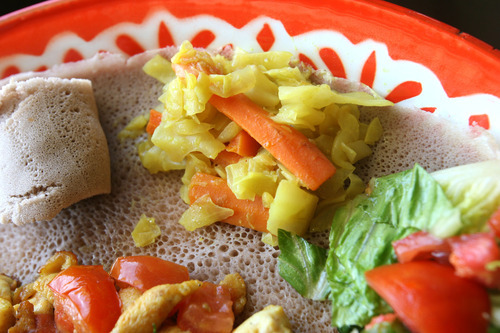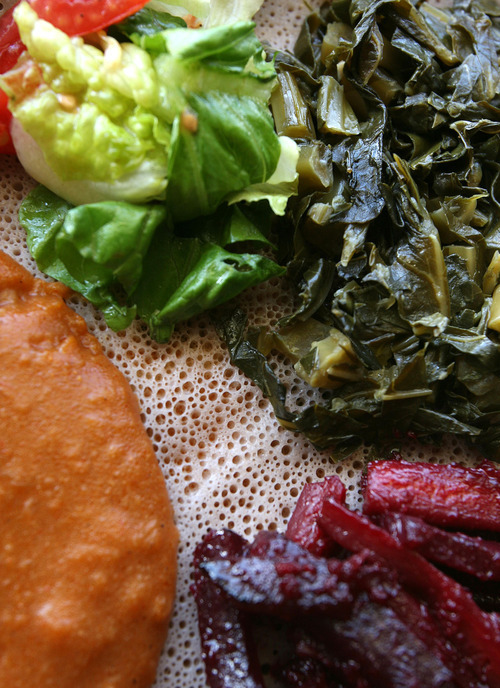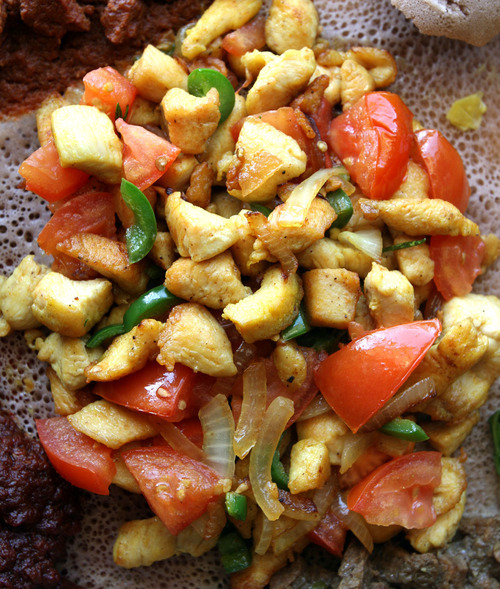This is an archived article that was published on sltrib.com in 2012, and information in the article may be outdated. It is provided only for personal research purposes and may not be reprinted.
Despite a recent mini-explosion of African restaurants across the valley, I find many local diners aren't well-versed in Ethiopian cuisine. Is it spicy? Are there odd ingredients? Would I like it? These are just a few of the questions I've heard recently. My usual answers: Not really, no, and go right ahead and try it.
Better questions might be: How do you feel about eating with your hands? And: Do you know what injera is?
After all, injera is the most unconventional aspect of Ethiopian dining that newcomers struggle to get to grips on. This spongy African bread serves as both a utensil, plate and carbohydrate in one. It's traditionally made from a soft teff flour — which is gluten-free and might be considered similar to quinoa or millet flour in cooking — while the Blue Nile restaurant adds in a little rice flour due to our elevation.
The restaurant then whips up a dough that's fermented for 18 hours, much like a sourdough starter. The restaurant makes injera daily by cooking the tangy dough on a hot plate, resulting in a pancake-like flat bread, peppered with tiny air bubbles. Texturally, the bread is soft and spongy, while there's a definite piquant edge from the fermentation in its taste.
As is traditional in Ethiopian cusine, meals are served family-style. Should you decide to forgo knives and forks at Blue Nile — and really, you should — you'll use a side order of injera to scoop, dip, dab and grab items from the communal platter.
Before getting to the main dishes, Blue Nile serves a couple appetizers worthy of note. Skip the lentil appetizers and the salad (it's served with entrees anyway) and order a serving of sambusa. Two deep-fried pastry shells come stuffed with lentils ($4.99) or ground beef ($$5.99), not unlike Indian samosa. Either option also comes with awaze, a hot, peppery dipping sauce, a traditional Ethiopian chile sauce that for heat aficionados has the intensity of sriracha.
I would direct novices immediately (as will the endlessly helpful staff at Blue Nile) to the meat ($12.99) and vegetable ($9.99) combination selections. Ordered together, these platters cover a large swathe of the menu and assist neophytes in getting up to speed quickly, both in terms of the flavor profiles and dexterous nature of Ethiopian dining.
The meat selection breaks down as kay wot (chopped prime beef, sauteed in clarified butter, then simmered in herbs and sauce), awaze tibs (cubed prime beef, cooked in spicy sauce) and doro wot (two tender chicken legs, a hard-boiled egg, cooked in a mild gravy). The veggie combo comes with tegabino shiro (pureed split peas with onions and garlic), yemisir wot (split lentils in gravy), ater alicha (yellow split peas in mild gravy), gomen (collard greens) and atkilt alicha (green beans and carrots).
My favorite is the yedora tibs ($12.99), which is ordered ala carte (as can all the items from the combos, too). Small chunks of chicken breast are marinated and cooked in clarified butter, jalapeno, onion, garlic and tomato, which results in a pleasingly smoky, almost barbecue-like flavor.
Clarified butter is used in many of the dishes to impart rich flavor, as is the spice mix of berbere — a melange of cardamom, pepper, chiles and cayenne. Another distinctive element of Ethiopian cuisine is the array of eye-popping colors, with platters often spanning a giddying spectrum, from the deep maroon-hued kay sir (beets and carrots, $6.99) to golden-sandy yellow split peas ($7.99).
Beyond injera, there's little to catch even the most modestly-experienced diner off guard, not that there aren't misses. Yebeg alicha, one of two lamb dishes, offered a scant serving at $14.99, and the small portion of lamb cooked in a mild gravy was also sadly dry and listless.
That same dryness could be found at times in beef dishes, too, while dessert is a non-event and worth skipping. I found the singular selection of baklava ($2.99) too heavy an item to end with — following a meal that already skews to the heavy side, thanks to the plate, spoon and carbohydrate of injera bread.
Dinner at Blue Nile is a comfortable, unrushed dining experience, and the service staffers seemed well-versed on the menu. Time and again, I found them accommodating, patient and eager to field questions — rushing back to the kitchen if stumped. The restaurant has a small offering of both beer ($3-$3.50) and wine ($4.00-$5.00), but sadly no Ethiopian Honey Wine just yet; the $4,000 fees for a DABC brewing license has proven to be a temporary stumbling block.
If you've yet to try Ethiopian cuisine and are in need of a gastronomic excursion, Blue Nile offers an accessible starting point. The main question you might find yourself asking after your meal might be is injera for me, which could be the start of a new dining experience.
Tribune restaurant reviewer Stuart Melling blogs at gastronomicslc.com. Send comments to food@sltrib.com. —
HH
Blue Nile
Food • HH
Service • HH
Mood • Hhj
Noise • bb
Blue Nile offers a comfortable introduction to the unique spices and hands of Ethiopian cuisine approach to this increasingly popular African cuisine.
Location • 755 South State St., Salt Lake City; 801-364-4042
Online • http://www.bluenileslc.com
Hours • Monday-Thursday, 11 a.m. to 9 p.m.; Friday-Saturday, 11 a.m. to 10 p.m.
Children's menu • Yes
Prices • $$
Liquor • Wine and beer
Reservations • No
Takeout • Yes
Wheelchair access • Yes
Outdoor dining • No
Credit cards • all major


